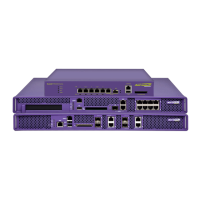Diagnostics
Summit WM3000 Series Controller System Reference Guide464
4 Highlight an existing log file to display the file's first page within the Preview field. Once a file is
selected, its name is appended within the preview field, and its contents are displayed.
The time, module, severity, mnemonic and description of the file are displayed.
5 Highlight a file from the list of log files available within the File Mgt tab and click the View button to
display a detailed description of the entire contents of the log file.
To view the entire content of an individual log file, see “Viewing the Entire Contents of Individual
Log Files” on page 464.
6 Click the Clear Buffer button to remove the contents of the File Mgt tab. This is only recommended if
you consider the contents of this file obsolete and wish to begin gathering new log file data.
When the button is selected, a confirmation prompt displays verifying whether the contents of the
log files is cleared.
7 Click the Transfer Files button to display a sub-screen wherein log files can be sent to an external
location (defined by you) using a user-defined file transfer medium.
On the Summit WM3700 controller users can also transfer log files using USB or Compact Flash. On the
Summit WM3600 controller users can also transfer log files using USB.
Transferring files is recommended when the log file is frequently cleared, but an archive of the log
files is required in a safe location. For more information on transferring individual log files, see
“Transferring Log Files” on page 466.
Viewing the Entire Contents of Individual Log Files
Extreme Networks recommends the entire contents of a log file be viewed to make an informed decision
whether to transfer the file or clear the buffer. The View screen provides additional details about a target
file by allowing the entire contents of a log file to be reviewed.
To display the entire contents of a log file:
1 Select Diagnostics > System Logging from the main menu tree.
2 Select the File Mgt tab.
3 Select an individual log file whose properties you wish to display in detail and click the View button.
Name
Displays a read-only list of the log files (by name) created since the last
time the display was cleared. To define the type of log files created, click
the
Log Options
tab to enable logging and define the log level.
Size
Displays the log file size in bytes. This is the current size of the file, if
modifications were made, they have been accounted for.
Created
Displays the date, year and time of day the log file was initially created.
This value only states the time the file was initiated, not the time it was
modified or appended.
Modified
Displays the date, year and time of day the log file was modified since its
initial creation date.

